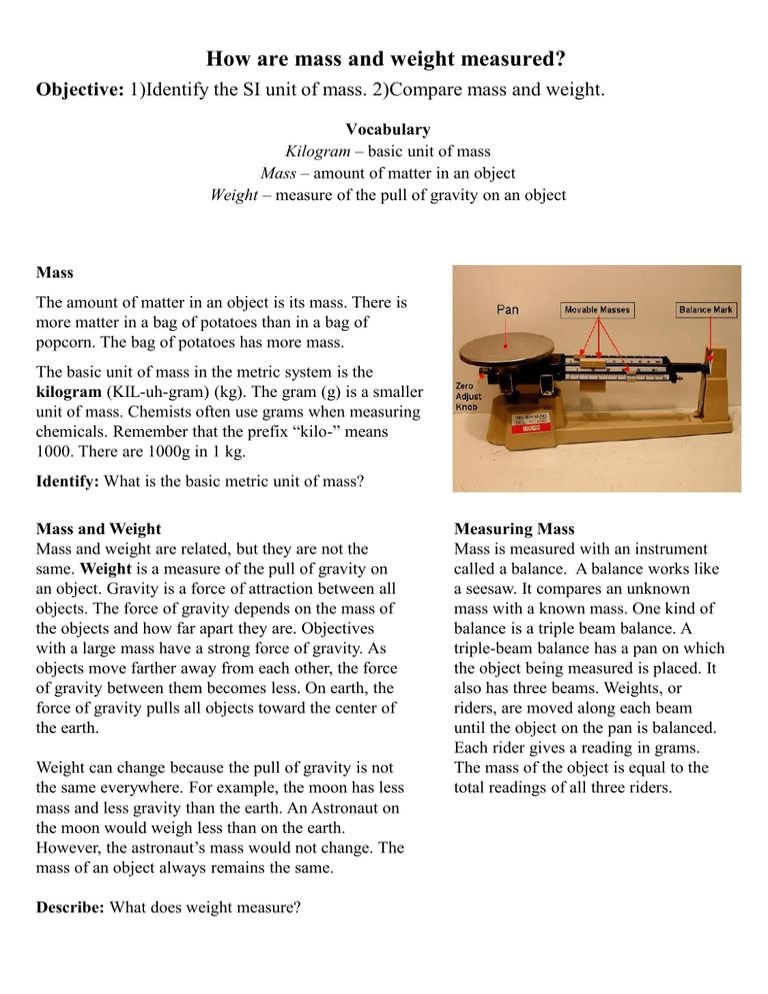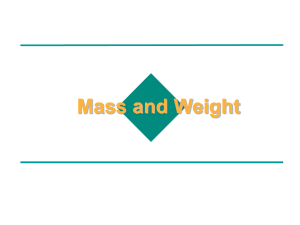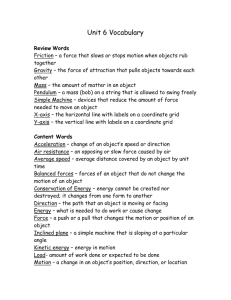How are mass and weight measured?
advertisement

How are mass and weight measured? Objective: 1)Identify the SI unit of mass. 2)Compare mass and weight. Vocabulary Kilogram – basic unit of mass Mass – amount of matter in an object Weight – measure of the pull of gravity on an object Mass The amount of matter in an object is its mass. There is more matter in a bag of potatoes than in a bag of popcorn. The bag of potatoes has more mass. The basic unit of mass in the metric system is the kilogram (KIL-uh-gram) (kg). The gram (g) is a smaller unit of mass. Chemists often use grams when measuring chemicals. Remember that the prefix “kilo-” means 1000. There are 1000g in 1 kg. Identify: What is the basic metric unit of mass? Mass and Weight Mass and weight are related, but they are not the same. Weight is a measure of the pull of gravity on an object. Gravity is a force of attraction between all objects. The force of gravity depends on the mass of the objects and how far apart they are. Objectives with a large mass have a strong force of gravity. As objects move farther away from each other, the force of gravity between them becomes less. On earth, the force of gravity pulls all objects toward the center of the earth. Weight can change because the pull of gravity is not the same everywhere. For example, the moon has less mass and less gravity than the earth. An Astronaut on the moon would weigh less than on the earth. However, the astronaut’s mass would not change. The mass of an object always remains the same. Describe: What does weight measure? Measuring Mass Mass is measured with an instrument called a balance. A balance works like a seesaw. It compares an unknown mass with a known mass. One kind of balance is a triple beam balance. A triple-beam balance has a pan on which the object being measured is placed. It also has three beams. Weights, or riders, are moved along each beam until the object on the pan is balanced. Each rider gives a reading in grams. The mass of the object is equal to the total readings of all three riders. Lesson Summary •Mass is the amount of matter in an object. •The basic unit of mass in the metric system is the kilogram. •Weight is a measure of the pull of gravity on an object. •The weight of an object can change, but its mass remains the same. •A balance is used to measure mass. Check Write true if the statement is true. If the statement is false, change the underlined term to make the statement true. 1. The amount of matter in an object is its weight. 2. The basic unit of mass in the metric system is the gram. 3. A balance is used to measure mass. 4. There are 100 grams is one kilogram. 5. An astronaut would weigh less on the moon than on the earth. 6. Weight is a force of attraction between all objects. Apply Complete the following. 7. Compare: What is the difference between mass and weight? 8. Calculate: Your weight on the moon would be only about one-sixth your weight on the earth. How much would you weigh on the moon? 9. Infer: The mass of mars is about one-tenth the mass of earth. Would an astronaut weigh more on Mars or Earth? Explain. 10. What unit would you use to measure the mass of a potato?





